Cholangitis vs Cholecystitis – detailed comparison:
Cholangitis
Cholangitis, also known as acute cholangitis (AC) or ascending cholangitis, is an infection of the bile duct, commonly caused by pathogenic bacteria ascending from its junction with the first part of the small intestine.
This infection of the biliary tract poses significant mortality and morbidity. It was first described in 1877 by Dr. Jean-Martin Charcot as “hepatic fever.”
There is no sex or race, which is at a notably higher risk of developing cholangitis. However, it mainly affects people in their 50s and 60s.
Up to 9 percent of people admitted to a hospital with gallstone disease have ascending cholangitis.
Causes
AC is a bacterial infection superimposed on an obstruction of the biliary tree, most frequently from a gallstone (hardened deposits of digestive fluid). During an obstruction, fluid combined with intraluminal pressure (which can occur with an increase in abdominal pressure) allows the harmful bacterial colonization of the biliary tree to become pathological.
The blockage may also be from blood clots, a tumor, swelling of the pancreas, a narrowing that may occur after a surgical procedure, or from parasite invasion.
Risk Factors
Risk factors include:
- an abnormally narrow bile duct, which can be congenital;
- travel to countries where you might catch a parasite or worm infection;
- HIV (human immunodeficiency virus);
- a previous history of gallstones;
- sclerosing cholangitis, a medical condition in which the ducts to the liver have been damaged.
Symptoms
Symptoms may include:
- clay-colored stools;
- pain in the right upper quarter of the abdomen;
- low blood pressure;
- high temperature (fever);
- decreased level of alertness;
- lethargy;
- dark urine;
- jaundice (yellowing of the skin and eyes);
- chills.
As the condition gets worse, symptoms may include:
- xanthomas (raised patches on the skin);
- swelling in the ankles, legs, or feet;
- diarrhea;
- weight loss;
- nausea;
- weakness.
Complications
Severe AC may cause:
- hepatic and/or hematological dysfunction;
- renal problems;
- cardiovascular dysfunction;
- acute kidney injury;
- septic shock (a life-threatening complication of sepsis that commonly results in death).
Treatment
It focuses on eliminating the infection with antibiotics to prevent sepsis (a serious infection that causes the immune system to attack the body). Sometimes, emergency surgery of the biliary tree may be needed.
Cholecystitis
It is an inflammation of the gallbladder – a small, pear-shaped organ that is located on the right side of the abdomen.
Causes
There are two types:
Acalculous cholecystitis develops as a complication of a serious infection, illness, or injury which damages the gallbladder. It is less common, but, it is usually a more serious type of acute cholecystitis.
Calculous cholecystitis usually occurs when gallstones (small stones that are made of cholesterol, which form in the gallbladder) block the cystic duct.
Gallstones are common. An estimated 10 to 20 percent of people in the United States have gallstones. Approximately fifty percent of people with gallstones will get cholecystitis.
Calculous cholecystitis is usually a less serious but more common type of acute cholecystitis. It accounts for about 95 percent of all cases.
Risk Factors
You have a higher chance of getting the condition if you are:
- diabetic;
- overweight or obese;
- a man older than 60;
- a woman older than 50.
Symptoms
Common symptoms include:
- fever;
- vomiting;
- nausea;
- tenderness over the abdomen when it is touched;
- pain which spreads to the right shoulder or back;
- severe pain in the center or upper right abdomen.
Note – unlike other forms of abdominal pain, the pain of this condition doesn’t go away within a few hours and is commonly persistent.
READ MORE: Mitochondrial DNA vs Nuclear DNA
Complications
The main complications may include:
- perforated gallbladder (or the gallbladder splitting open) – it can lead to a build-up of pus or spread the infection within the abdomen;
- cholecystoenteric fistula – it creates a fistula into the small bowel, which may pass freely or obstruct the small bowel;
- gangrenous cholecystitis – it is the death of the tissue of the gallbladder. This complication can cause a serious infection that could spread throughout the body;
- gallstone pancreatitis – it occurs when stones travel from the gallbladder and block the opening to the 1st part of the small intestine;
- Mirizzi syndrome – it is a rare complication in which a gallstone becomes impacted in the cystic duct and compresses the common bile duct.
READ MORE: Shortness of Breath After Surgery
Treatment
Treatment of the condition depends on the presence or absence of complications and the severity of the condition. Treatments may include:
Procedure to remove the stone(s) – your healthcare specialist may perform endoscopic retrograde cholangiopancreatography, a medical procedure that removes any stones blocking the cystic duct or bile ducts.
Pain drugs – they can help control pain until the inflammation in the gallbladder is relieved.
Antibiotics – if the gallbladder is infected, your healthcare provider will likely recommend antibiotics.
To prevent dehydration, your doctor may give you fluids through a vein in your arm.
Fasting – in order to take the stress off the inflamed gallbladder, you may not be allowed to drink or eat at first.
READ MORE: Ribose vs Deoxyribose
Cholangitis vs Cholecystitis – Differences
According to a March 2017 study done at the Unit of General Surgery Papa Giovanni XXIII Hospital, Italy, acute cholangitis is a bacterial infection that is caused by an obstruction of the biliary tree, independent of the cystic duct and gallbladder, leading to elevated intraluminal pressure and bile infection.
On the other hand, acute cholecystitis is a bacterial infection that is produced by an obstruction of the cystic duct by gallstones.
READ THIS NEXT: Cerebrum vs Cerebellum
References https://www.ncbi.nlm.nih.gov/pubmed/9551680 http://pediatrics.aappublications.org/content/80/6/918 https://aasldpubs.onlinelibrary.wiley.com/doi/full/10.1002/cld.633
